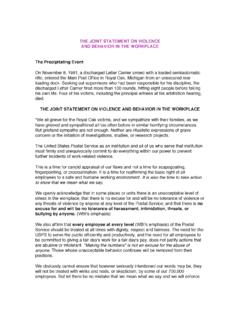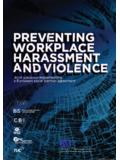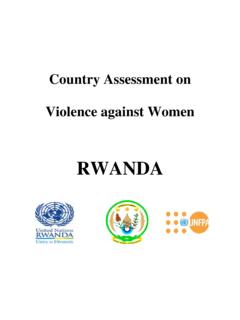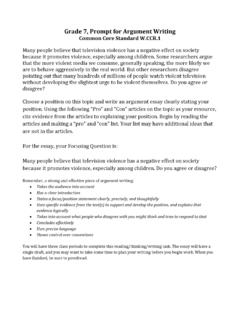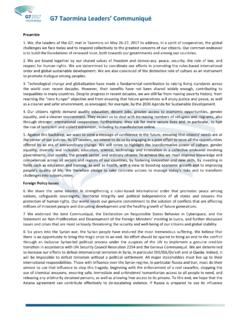Transcription of Health and Safety Executive Violence at work
1 Health and Safety Executive Violence at work A guide for employers People who deal directly with the public may face aggressive or violent behaviour. They may be sworn at, threatened or even attacked. This document gives practical advice to help you find out if Violence is a AT W O R K. a guide for employers problem for your employees, and if it is, how to tackle it. The advice is aimed at employers, but should also interest employees and Safety representatives. Violence is .. The Health and Safety Executive 's definition of work-related Violence is: any incident in which a person is abused, threatened or assaulted in circumstances relating to their work'. This is a web-friendly version of leaflet Verbal abuse and threats are the most common types of incident. Physical attacks INDG69(rev), revised are comparatively rare. 10/96. Who is at risk? Employees whose job requires them to deal with the public can be at risk from Violence .
2 Most at risk are those who are engaged in: giving a service caring education cash transactions delivery/collection controlling representing authority Is it my concern? Both employer and employees have an interest in reducing Violence at work. For employers, Violence can lead to poor morale and a poor image for the organisation, making it difficult to recruit and keep staff. It can also mean extra cost, with absenteeism, higher insurance premiums and compensation payments. For employees, Violence can cause pain, distress and even disability or death. Physical attacks are obviously dangerous but serious or persistent verbal abuse or threats can also damage employees' Health through anxiety or stress. 1 of 7 pages Health and Safety Executive What the law requires There are five main pieces of Health and Safety law which are relevant to Violence at work. These are: The Health and Safety at Work etc Act 1974 (HSW Act).
3 Employers have a legal duty under this Act to ensure, so far as is reasonably practicable, the Health , Safety and welfare at work of their employees. The Management of Health and Safety at Work Regulations 1999. Employers must assess the risks to employees and make arrangements for their Health and Safety by effective: - planning;. - organisation;. - control;. - monitoring and review. The risks covered should, where appropriate, include the need to protect employees from exposure to reasonably foreseeable Violence . The Reporting of Injuries, Diseases and Dangerous Occurrences Regulations 1995 (RIDDOR). Employers must notify their enforcing authority in the event of an accident at work to any employee resulting in death, major injury or incapacity for normal work for three or more consecutive days. This includes any act of non- consensual physical Violence done to a person at work. Safety Representatives and Safety Committees Regulations 1977 (a) and The Health and Safety (Consultation with Employees) Regulations 1996 (b).
4 Employers must inform, and consult with, employees in good time on matters relating to their Health and Safety . Employee representatives, either appointed by recognised trade unions under (a) or elected under (b) may make representations to their employer on matters affecting the Health and Safety of those they represent. Effective management of Violence A straightforward four stage management process is set out below and is further described on pages 2-5 and in Health risk management (see Where can I get further information?' for details). Stage 1 Finding out if you have a problem Stage 2 Deciding what action to take Stage 3 Take action Stage 4 Check what you have done It is important to remember that these four stages are not a one-off set of actions. If stage 4 shows there is still a problem then the process should be repeated again. Stages 1 and 2 are completed by carrying out a risk assessment.
5 Stage 1 Finding out if you have a problem The first step in risk assessment is to identify the hazard. You may think Violence is not a problem at your workplace or that incidents are rare. However, your employees' view may be very different. A major petrol company was not aware of the size of the problem faced daily by forecourt employees, until it sought their views during a series of meetings. Filling station employees believed strongly that increased customer Violence was the most serious threat to their personal Health and Safety . Violence 2 of 7 pages Health and Safety Executive Ask your staff - do this informally through managers, supervisors and Safety representatives or use a short questionnaire to find out whether your employees ever feel threatened. Tell them the results of your survey so they realise that you recognise the problem. Keep detailed records - it is a good idea to record incidents, including verbal abuse and threats.
6 You may find it useful to record the following information: an account of what happened;. details of the victim(s), the assailant(s) and any witnesses;. the outcome, including working time lost to both the individual(s) affected and to the organisation as a whole;. the details of the location of the incident. For a variety of reasons some employees may be reluctant to report incidents of aggressive behaviour which make them feel threatened or worried. They may for instance feel that accepting abuse is part of the job. You will need a record of all incidents to enable you to build up a complete picture of the problem. Encourage employees to report incidents promptly and fully and let them know that this is what you expect. Classify all incidents - use headings such as place, time, type of incident, potential severity, who was involved and possible causes. It is important that you examine each incident report to establish whether there could have been a more serious outcome.
7 Here is an example of a simple classification to help you decide how serious incidents are: fatal injury;. major injury;. injury or emotional shock requiring first aid, out-patient treatment, counselling, absence from work (record number of days);. feeling of being at risk or distressed. It should be easy to classify major injuries' but you will have to decide how to classify serious or persistent verbal abuse' for your organisation, so as to cover all incidents that worry staff. You can use the details from your incident records along with the classifications to check for patterns. Look for common causes, areas or times. The steps you take can then be targeted where they are needed most. A survey by a trade union after 12 separate shop robberies found that each incident occurred between 5 and 7 o'clock in the evening. This finding could have useful security lessons for late night opening of stores and shops.
8 Try to predict what might happen - do not restrict your assessment to incidents which have already affected your own employees. There may be a known pattern of Violence linked to certain work situations. Trade and professional organisations and trade unions may be able to provide useful information on this. Articles in the local, national and technical press might also alert you to relevant incidents and potential problem areas. Stage 2 Deciding what action to take Having found out that Violence could be a problem for your employees you need to decide what needs to be done. Continue the risk assessment by taking the following steps to help you decide what action you need to take. Violence 3 of 7 pages Health and Safety Executive Decide who might be harmed, and how Identify which employees are at risk - those who have face-to-face contact with the public are normally the most vulnerable. Where appropriate, identify potentially violent people in advance so that the risks from them can be minimised.
9 Evaluate the risk Check existing arrangements, are the precautions already in place adequate or should more be done? Remember it is usually a combination of factors that give rise to Violence . Factors which you can influence include: the level of training and information provided;. the environment;. the design of the job. Consider the way these factors work together to influence the risk of Violence . Examples of preventive measures are listed at the bottom of this page. Training and information Train your employees so that they can spot the early signs of aggression and either avoid it or cope with it. Make sure they fully understand any system you have set up for their protection. Provide employees with any information they might need to identify clients with a history of Violence or to anticipate factors which might make Violence more likely. The environment Provide better seating, decor, lighting in public waiting rooms and more regular information about delays.
10 Consider physical security measures such as: video cameras or alarm systems;. coded security locks on doors to keep the public out of staff areas;. wider counters and raised floors on the staff side of the counter to give staff more protection. The design of the job Use cheques, credit cards or tokens instead of cash to make robbery less attractive. Bank money more frequently and vary the route taken to reduce the risk of robbery. Check the credentials of clients and the place and arrangements for any meetings away from the workplace. Arrange for staff to be accompanied by a colleague if they have to meet a suspected aggressor at their home or at a remote location. Make arrangements for employees who work away from their base to keep in touch. Maintain numbers of staff at the workplace to avoid a lone worker situation developing. Violence 4 of 7 pages Health and Safety Executive The threat of Violence does not stop when the work period has ended.










